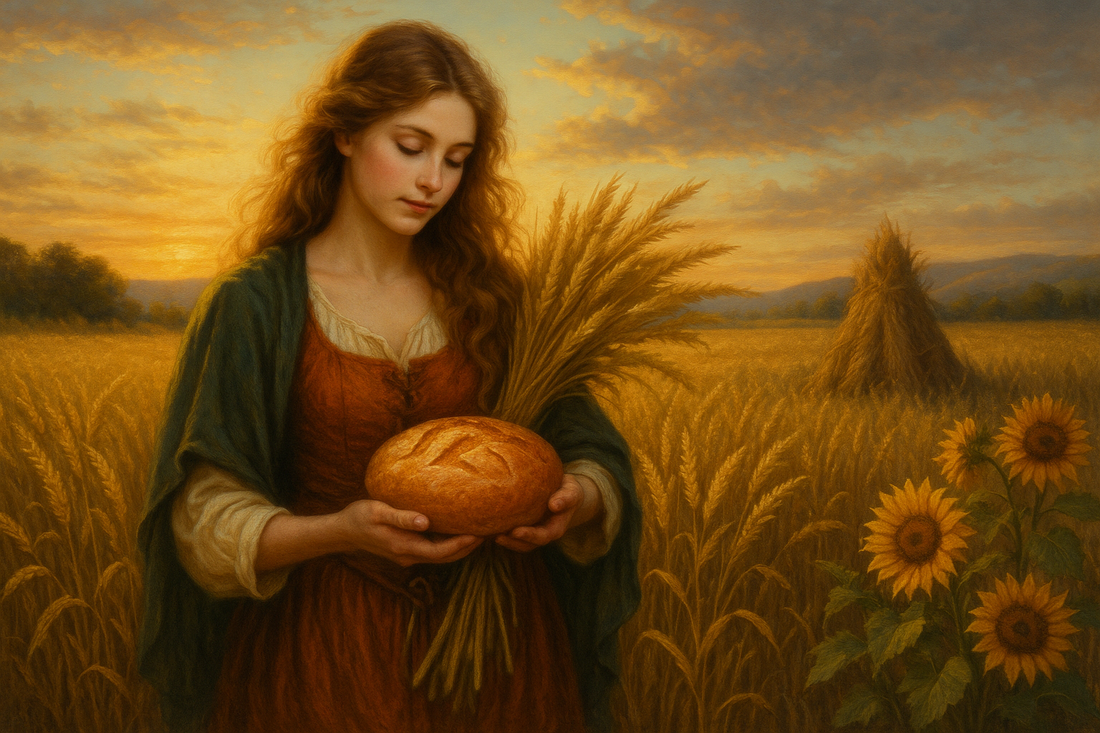
Lammas : Gratitude pour la première récolte
Partager
- Lammas : Gratitude pour la première récolte
- La première récolte et son importance
- Traditions et façons de célébrer Lammas
- Cuisson du pain :
- Festin et communauté :
- Offrandes à la Terre :
- Correspondances de Lammas
- Rituel de Lammas : Cuire du pain pour la gratitude
- Embrasser la gratitude et l'abondance à Lammas
Lammas, également connu sous le nom de Lughnasadh , est une fête païenne des premières récoltes célébrée autour du 1er août dans l'hémisphère nord (et autour du 1er février dans l'hémisphère sud). Alors que la Roue de l'Année tourne vers la fin de l'été, Lammas marque le début de la moisson des céréales – une période où les champs offrent leurs récoltes de blé, de maïs et d'orge. Le nom de ce sabbat, « Lammas », vient de « masse de pain », reflétant la tradition de cuire la première miche de pain à partir du nouveau grain. Lughnasadh , quant à lui, honore le dieu celtique Lugh. Selon la légende, Lugh aurait instauré cette fête en mémoire de sa mère adoptive Tailtiu, décédée après avoir défriché les champs d'Irlande pour l'agriculture. Qu'on l'appelle Lammas ou Lughnasadh, cette fête des récoltes, inspirée par la sorcellerie, est centrée sur l'abondance, la communauté et la gratitude pour la générosité de la Terre Mère.
La première récolte et son importance
Dans le cycle agraire traditionnel, Lammas est la célébration pleine de gratitude de la première récolte . C'est le premier des trois sabbats de la moisson (suivis de Mabon et de Samhain), consacré à la cueillette des céréales et des premiers fruits. Lors de Lammas, des gerbes de blé dorées sont prêtes dans les champs et les premiers produits du jardin sont mûrs. Dans de nombreuses communautés anciennes, la première gerbe de blé était coupée cérémoniellement, cuite en un pain sacré et offerte à la terre ou à la divinité en remerciement – un sacrifice symbolique pour assurer la prospérité des récoltes suivantes. La dernière gerbe pouvait être façonnée en poupée de maïs représentant l'esprit de la moisson, conservée ou enterrée jusqu'à la prochaine saison des semis comme un charme pour une abondance renouvelée. Ces traditions nous rappellent que la moisson est un cycle de recevoir et de donner : nous récoltons les fruits d'un dur labeur et nous mettons également de côté des semences (au sens propre comme au figuré) pour l'avenir.
Pour les sorcières et les païens modernes, Lammas est l'occasion de prendre le temps de réfléchir à ce que nous avons « récolté » cette année. C'est le moment de célébrer les résultats, petits ou grands : les projets terminés, le développement personnel accompli ou les leçons apprises. Tout comme les agriculteurs évaluent le rendement de leurs champs, nous pouvons examiner les intentions que nous avons semées plus tôt dans l'année et voir ce qui se concrétise. La gratitude est le thème central de Lammas. En reconnaissant et en remerciant la Terre et l'Esprit pour notre abondance, nous nous alignons sur le cycle de la générosité de la nature. Cette gratitude est également porteuse d'une confiance profonde : d'autres bienfaits continueront à se manifester au fil de l'année.
Traditions et façons de célébrer Lammas
Cuisson du pain :
L'une des traditions les plus appréciées des Lammas est la cuisson du pain issu des premières récoltes. De nombreux praticiens préparent un pain spécial (souvent rond ou tressé, symbolisant le soleil ou la roue de l'année) et le bénissent dans le cadre de leur rituel de Lammas. Partager ce pain avec la famille, le coven ou les amis, ou même en offrir un morceau à la terre ou à la faune, est un acte de remerciement significatif. Le simple fait de cuire devient un rituel sacré lorsqu'il est accompli avec intention, imprégnant le pain de prières de gratitude et d'abondance.
Festin et communauté :
Lammas est un moment joyeux de rassemblement et de célébration. Historiquement, il était marqué par de grandes fêtes, des foires, des danses et même des jeux ou compétitions sportives en l'honneur de Lugh. Aujourd'hui, vous pouvez organiser une célébration de Lughnasadh sous forme de pique-nique ou de repas partagé. Invitez d'autres païens ou vos proches à apporter des plats préparés avec des produits de saison (pâtisseries fraîches, épis de maïs, confitures de baies, etc.). Pendant le repas, partagez à tour de rôle les bénédictions pour lesquelles vous êtes reconnaissants. Ce « cercle de gratitude » transforme le repas en un puissant rituel communautaire de remerciement. Si vous pratiquez seul, vous pouvez toujours vous préparer un repas de fête des récoltes – par exemple un ragoût copieux avec des légumes du jardin, une miche de pain et une tasse de cidre ou d'hydromel – et le savourer en pleine conscience en l'honneur de la saison.
En récoltant les prémices de notre travail, rappelons-nous que l'abondance ne réside pas seulement dans ce que nous recevons, mais aussi dans ce que nous partageons. La fraction du pain devient un acte sacré lorsqu'elle est accomplie avec gratitude. — Bénédiction traditionnelle de Lammas
Offrandes à la Terre :
Parce que Lammas est une occasion de remercier la Terre, faire des offrandes est une pratique courante. Vous pouvez verser un peu de bière, de vin ou de lait sur le sol en guise d'offrande traditionnelle, ou laisser du pain, des fruits ou des herbes en cadeau aux esprits de la nature (assurez-vous simplement que vos offrandes soient écologiques). Certaines sorcières aiment trouver un lieu sacré en plein air – comme un champ, un jardin ou sous leur arbre préféré – et y effectuer un simple rituel de remerciement. Par exemple, vous pouvez ramasser une petite botte de blé ou de fleurs sauvages, prononcer des mots de gratitude et la déposer sur la terre en signe de reconnaissance.
Correspondances de Lammas
En sorcellerie, utiliser les correspondances saisonnières pour un sabbat peut approfondir votre connexion à son énergie. Voici quelques correspondances clés pour les Lammas :
| Catégorie | Correspondances |
|---|---|
| Couleurs | Or, jaune, orange, rouge, bronze, marron, vert |
| Symboles | Gerbes de blé, maïs, pain, tournesols, poupées de récolte |
| herbes | Blé, orge, maïs, tournesol, souci, menthe, basilic |
| Cristaux | Cornaline, citrine, œil de tigre, ambre, aventurine verte |
| Aliments | Pain, maïs, baies, pommes, miel, bière, hydromel |
Rituel de Lammas : Cuire du pain pour la gratitude
Pour véritablement saisir l'esprit de Lammas, pensez à pratiquer un rituel de Lammas simple mais puissant, centré sur la cuisson du pain. Il s'agit à la fois d'une recette et d'un rituel , adapté aux pratiquants de tous niveaux. En créant cette offrande de gratitude, vous incarnez la tradition ancestrale d'honorer la première récolte.
Commencez par rassembler vos ingrédients avec intention. En mélangeant la pâte, remuez dans le sens des aiguilles d'une montre pour honorer l'énergie vitale du Soleil. Lors du pétrissage, imprégnez chaque poussée et chaque pliage de gratitude, en nommant vos bénédictions à voix haute ou dans votre cœur. Le contact tactile avec la pâte devient une méditation sur l'abondance.
Donnez à votre pain une forme précise, par exemple en symbole solaire rond ou tressé pour représenter l'interdépendance de la vie. Pendant qu'il cuit, emplissant votre maison de cet ineffable parfum de possibilités, contemplez tout ce que vous avez récolté dans votre vie.
Une fois terminé, rompez ce pain sacré avec vos proches ou savourez-le en toute solitude, savourant chaque bouchée comme une communion avec la générosité de la terre. N'oubliez pas que la perfection ne réside pas dans l'apparence de votre pain, mais dans la sincérité de votre gratitude.
Embrasser la gratitude et l'abondance à Lammas
Lammas est avant tout une célébration de la gratitude – un moment pour saluer les fruits de notre travail et les bienfaits qui nous entourent. En tant que sorcières et personnes spirituelles, en célébrant cette première fête des récoltes , nous faisons plus que perpétuer une vieille tradition ; nous participons activement au cycle de la nature. En remerciant la terre maintenant, nous renforçons notre lien avec elle et ses rythmes. En partageant notre abondance (qu'il s'agisse de nourriture, de savoir, d'amour et de bienveillance), nous invitons encore plus d'abondance à nous revenir. Dans l'esprit du « ce que je récolte, je le sème », Lammas nous rappelle que l'énergie que nous déployons dans le monde nous sera rendue trois fois plus .
Que vous fêtiez en grand groupe autour d'un feu de joie ou que vous contempliez tranquillement le coucher du soleil de Lammas avec une tasse de thé, sachez que vous faites partie d'un réseau ancien et mondial de célébrations des récoltes. Prenez un moment pour ressentir pleinement ce lien : vos ancêtres ont probablement célébré ce moment à leur manière, en remerciant pour les céréales qui leur permettraient de passer l'hiver. De même, vous pouvez perpétuer cet héritage d'une manière qui correspond à votre vie actuelle, en faisant revivre la magie d'antan.
Alors que l'été s'adoucit et que les nuits rallongent, Lammas offre l'occasion de se ressourcer . Saluez le chemin parcouru cette année et savourez les fruits de vos efforts. Reconnaître ses accomplissements a une magie particulière : cela vous propulse vers l'avant avec une confiance renouvelée. Et si tous vos objectifs de l'année ne se sont pas encore concrétisés, ce n'est pas grave. La saison des récoltes ne fait que commencer, et il est temps de poursuivre la croissance et de se donner une seconde chance (tout comme les récoltes plus tardives mûriront lors des prochains sabbats).
